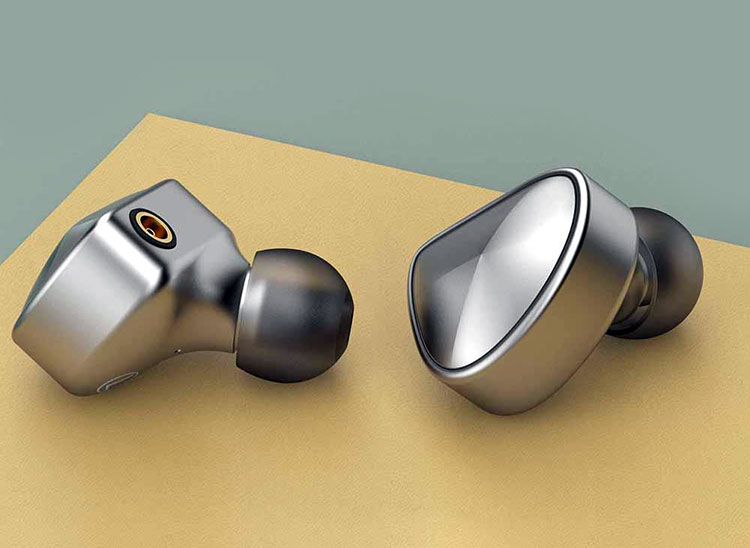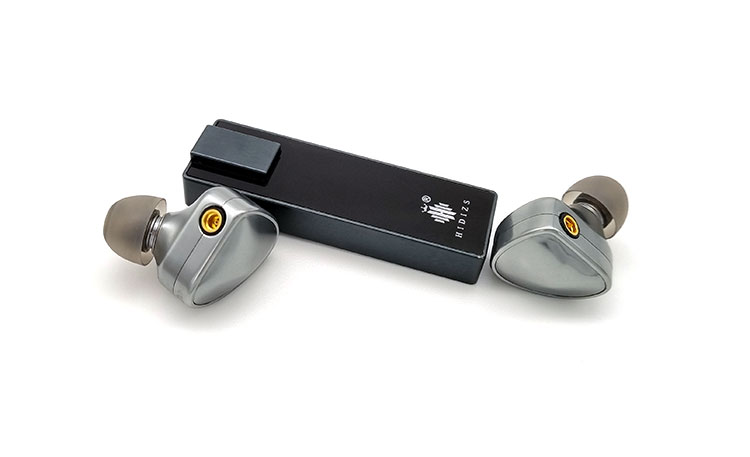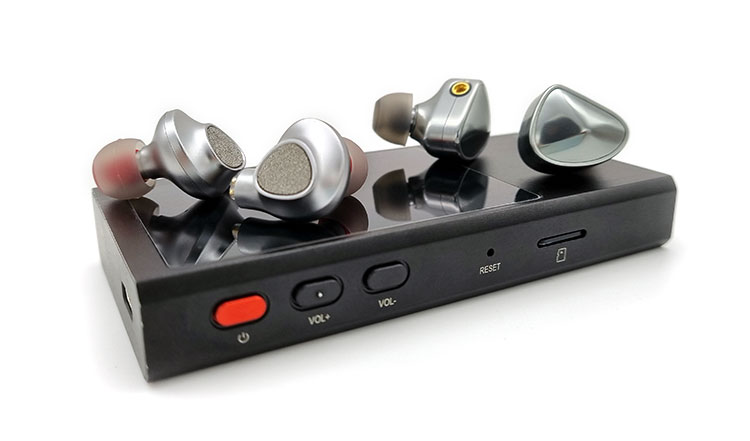Synergy
Efficiency
The P.D.1 is a fairly efficient IEM, given its 16-ohm impedance @1kHz, and a sensitivity of 110dB/Vrms@1kHz. As per usual, I tested the P.D.1 with a multitude of sources.
On the Sony NW-A105, the P.D.1 is easily driven to a listenable volume at 60 steps of adjustment on its built-in digital volume control. The NW-A105 is a fairly weak source that favors clean power output over raw, voluminous power.
Nevertheless, the P.D.1 retains its original signature, albeit with a little more drag in the sub-bass regions, the by-product of an average damping factor.
Power
With the Hidizs S9 Pro, a dedicated dongle DAC/amp with a 2.5mm balanced out, the P.D.1 seems to respond favorably to additional power. In its balanced configuration, the P.D.1’s low end tightens up slightly. But the apple does not fall too far from the tree; the P.D.1 still retains its familial, signature sound.
Volume is most certainly a non-issue. On my Samsung S21, less than half its maximum volume is beyond adequate for on-the-go listening, accounting for the surrounding noise that vented IEMs are susceptible to.
The xDuoo’s X20’s house sound is distinctly upper-mid forward, sacrificing body and note weight in favor of the raw resolution. Paired with the P.D.1 from its balanced output, and the P.D.1’s W-shaped signature finds its slubby bass response muzzled by the X20 when compared to the Hidizs S9 Pro.
Female vocals are given new life, but treble stridency issues are now more prevalent as a result of this pairing. Unsurprisingly, the X20’s low gain mode far surpasses what is necessary for the P.D.1 to be driven to a comfortable listening volume.
In terms of driveability, the P.D.1 is a breath of fresh air when placed side-by-side with its planar relatives/competition. It is highly sensitive, easily driven and it remains consistent sound-wise with very slight deviations when driven with additional power.
It is a versatile product that responds decently well to driving power, without it being a necessity. The P.D.1 is an excellent grab-and-go solution.
Select Comparisons
Tin HiFi P2
Technical
Apart from the missing dynamic driver, the Tin HiFi P2 is a similar beast, with a 12mm planar-magnetic transducer. However, the P2 is a far less sensitive IEM that demands significant current for it to truly shine. Price-wise, both earphones fall in the same mid-range flagship bracket. I think it is only fitting to place both fighters in the same boxing ring.
Performance
Right out the gate, there are several differences between both products that distinguish one from the other. However, there are clear eccentricities that both planar drivers seem to display.
For starters, the P2 has a slightly V-shaped sound signature with a robust low-end and distinct treble. Opposition ally, the P.D.1 is a W-shaped IEM with a draggier low end and a slightly upper-mid boost that bolsters the entire signature. What makes them more similar than different, lies in their timbre properties.
Both of them share the same “glaring issues” in the treble (pun intended), and a bass-response that is at odds with traditional planar orthodoxy.
Lows
While it is true that both IEMs are fairly resolving, with laudable transients in terms of attack and decay, they still share a slower, deeper sustain as compared to the planar-magnetic drivers found in full-sized headphones.
However, the spontaneity of the P2 still makes it the snappier earphone. Kickdrums attack and decay faster with a solid mid-bass body, while the P.D.1 has a slower bass bloom that accentuates deeper, thicker notes. On acoustic and classical guitars, it is a blessing. On percussive sections, it is a boon.
Mids
The P2’s midrange is similarly tuned when placed next to the P.D.1. The P2’s upper-midrange is boosted up slightly, with a lower-midrange that lags behind slightly. However, the proportions between them differ.
The valley between the upper-midrange and the lower-midrange on the P.D.1 is proportionally wider, with a slight boost in the lower-midrange, and the upper-midrange.
Detail retrieval loses out slightly on the P.D.1, but overall, it adopts a more organic approach that tastefully complements warmer recordings. Oddly enough, the P2 captures more sonic details in the upper midrange despite its more modest presentation.
Coherency on the P.D.1 is more grounded too, retaining the timbre properties of the instruments it presents in a dynamic driver-like fashion.
Highs
The highs in the P2 are more relaxed, the upper midrange taking over its presence as a means to taper off any sibilant highs, and resonant peaks. The P2 as a whole sounds proportionally darker with those smooth-out upper registers.
On the other hand, the P.D.1 gives the highs more elbow room to extend upwards. Some can see this as a double-edged sword, with the highs given space to breathe, at the risk of allowing for strident peaks.
Shozy Phantom
Technical
The Shozy B2 (AKA the Phantom), is a single, 10mm carbon nanotube (CNT) dynamic driver IEM that is priced at $439. While it is no planar-magnetic IEM, it is a highly competent mid-range flagship contender.
Performance
I think it is safe to say that both brands and the teams behind them share a confluence of ideas when it comes to tuning philosophies. But one is far more extreme than the other, with a deeply exaggerated L-shaped frequency response.
The B2 is a dark horse of an IEM; its lower-midrange weight is thick, syrupy, and overly saccharine. Sustain is the name of the game, where its slower resolving nature is akin to that of the Martin brand of acoustic guitars. It is a chambered sound that is mature and inviting.
The P.D.1 tries to straddle the lines of acoustic warmth without sacrificing out on the upper-midrange, and the highs. As a result, it attempts to balance the excitement of a mild V-shape with a L-shaped frequency response.
Lows
Bombastic, full-bodied, and decelerated is how I would describe the Phantom B2. It is unashamedly non-reference in its tuning methodologies. It does not quite achieve the title of “bass cannons”. Instead, the bass reverberates throughout each test track, dissipating slowly.
The P.D.1 is certainly not that, with a conservative, and tepid bass bloom that is miles away from the B2’s luscious bass response. The P.D.1 is more approachable with a larger selection of genres, far more adept at adapting to changing circumstances.
Mids
By virtue of its deeply saturated low-end, the B2’s midrange carries the exact same character as its low end. The lower midrange is cloyingly sweet, with thick weight notes soaked in reverb-like sustain. It envelopes the entire signature for an emotive versus precise listen.
History repeats itself, with the P.D.1 featuring a more lukewarm response that allows for a stronger emphasis on the upper midrange to compensate for the restrained bass bloat.
The P.D.1 presents the midrange in a clearer fashion, unmuddied by a low-end that bleeds into it. But it is worth noting that the B2’s technical prowess still manages to present those sonic details, albeit behind the entirety of the mix.
Highs
The B2’s highs are significantly nullified by its L-shaped frequency response. It is noticeably rolled off, tapering off early in each test track to avoid any risk of harshness, and sibilance.
Instead of a porous, crystalline high section, the B2 does it away with it completely. It still retains a fair amount of detail, but it attempts to downplay it in favor of the bottom end of its L-shaped frequency response.
The P.D.1 instead, opts for a more traditional style that allows the upper registers to extend until it hits a set ceiling. Unfortunately, I think that threshold is set far too high, with the P.D.1 sometimes crossing my tolerance for harshness. On a positive note, female vocals and string instruments are given ample space to extend outward, its sonorous details captured.
Our Verdict
The P.D.1 successfully manages to tame the planar-magnetic driver’s overly enthused character with the addition of an extra dynamic driver. Its above-average detail retrieval, cabin-like warmth, and tasteful low-end bucks my preconceived planar-magnetic expectations.
While there is still room for improvement in several areas, I commend HarmonicDyne for thinking outside the box with their first foray into the IEM marketplace.
If you are looking for a planar-magnetic IEM that is well suited to casual listening sessions without requiring inordinate amounts of power, the P.D.1 is worthy of consideration.
HarmonicDyne P.D.1 Specifications
- Natural, Smooth Sound tuning.
- 10mm Customized high-magnetic flux high-sensitivity Planar driver.
- 10mm high-efficiency Dynamic driver (CNTs for edge+DLC for dome).
- Exquisite build with Aviation-grade aluminum alloy ear shells.
- Crafted using high-precision 5-axis CNC machining process.
- Bundled with two high-purity cables (Copper silver hybrid balanced 4.4mm cable, Silver-plated OFC copper 3.5mm cable).
- Standard MMCX Connectors.
- Impedance: 16Ω@1kHz.
- Frequency response: 10Hz-40kHz.
- THD+N: ≤0.2%@1kHz.
- Sensitivity: 110dB/Vrms@1kHz.





